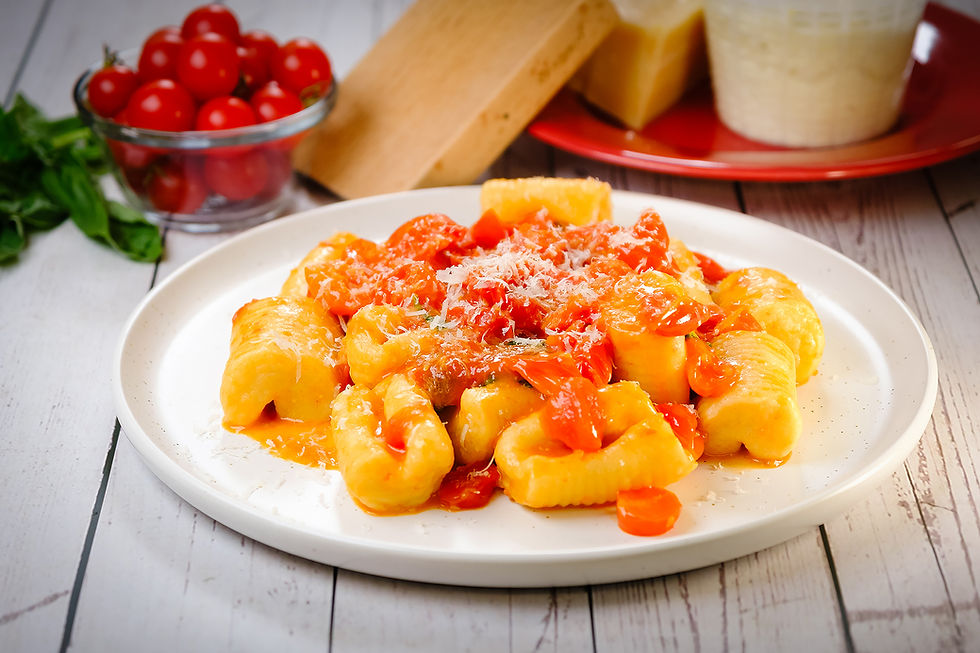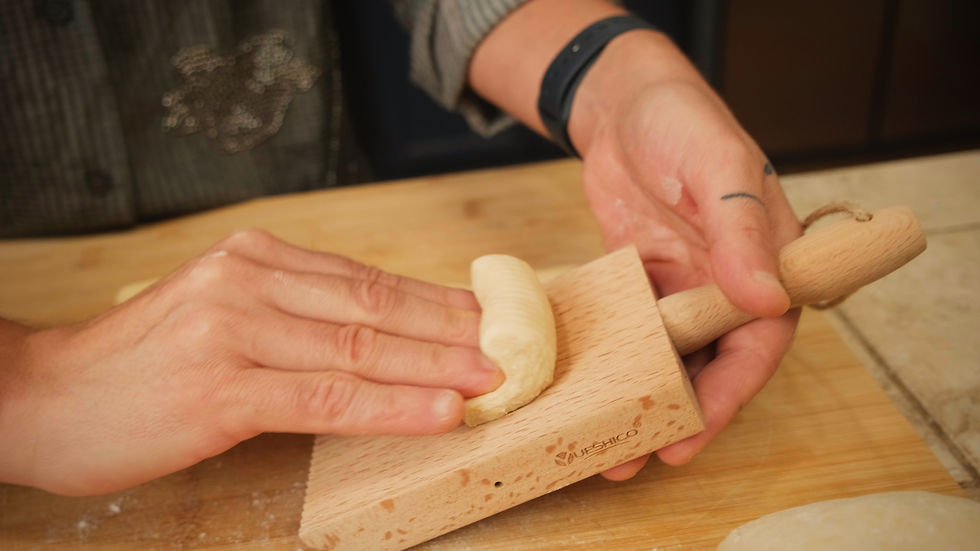Ndunderi di Minori | How to Make Ricotta Gnocchi
- Pasta Grammar

- Aug 25, 2024
- 3 min read
Ndunderi are a type of pasta from Minori, on the Amalfi coast. They are shaped like potato gnocchi, but differ in that the dough is made with ricotta and they are substantially larger than traditional gnocchi. The ricotta dough allows for a much larger and thicker pasta, which means that each piece is a very big dumpling.

Ndunderi have an incredible and unique texture because the thickness creates a wide gradient of tenderness: the outside becomes soft, starchy and gooey while the inside remains firm and al dente. They can be paired with almost any sauce: from simple tomato sugo to ragù (a popular choice in Minori).
How to Treat the Ricotta
When making ricotta dumplings, it’s important to work with ricotta that isn’t too wet. To avoid this, we recommend placing the ricotta in a fine mesh sieve suspended over a bowl. Cover the ricotta in plastic wrap and let it drain in the fridge overnight. Please note that the amount of ricotta listed below is by weight after draining.
Watch the Pasta Grammar video:
NDUNDERI DI MINORI RECIPE
Makes: 2 to 3 servings
Cook Time: 1 hour
For this recipe, you will need:
7 ounces (200 g) drained ricotta
1 ¼ cups (150 g) all-purpose flour, plus extra for dusting
3 ounces (85 g) Parmigiano-Reggiano cheese, grated
1 large egg
A pinch of grated nutmeg
Salt
In a bowl, combine the ricotta, flour, cheese, egg, nutmeg, and a pinch of salt. Mix all together until a rough dough forms, then transfer to a clean work surface.
Knead the dough until it is even and no longer sticky, but try not to do so for too long: the more you knead the dough, the stickier it will become and you will have to add more flour which will then make the pasta denser. Place the dough back in the mixing bowl, cover it with plastic wrap or a lid, and let it rest in the fridge for 20 minutes.
After the dough has rested, lightly dust and rub it with flour and cut off a manageable chunk—about a third of the total. Roll this chunk out beneath your palms into a thick, even snake—about 1 ½ inches (3.75 cm) thick. Cut the dough strand into equal pieces, each about 3 fingers-width long. Liberally dust the pieces with flour.

Place one piece horizontally at the top of a ridged gnocchi board, held at a 45° angle with the bottom resting on your work surface. Press three finger tips into the dough while rolling it down the board. The result should be a dumpling with a ridged pattern on one side and a deep hole on the other. If you don’t have a gnocchi board, you can simply roll the piece along any flat surface and skip the ridged texture. Place the finished pasta piece on a plate or tray dusted with flour and repeat until all of the pasta dough has been rolled, cut and shaped.
To cook the pasta, bring a large pot of water to boil and salt it generously. Carefully add the ndunderi into the water, give them a gentle stir, and let them boil until they rise to the surface of the water. Two minutes after they have risen, use a slotted spoon to transfer them into a large pan of your favorite sauce. Gently toss the pasta and sauce together over medium/high heat until the pasta is evenly coated, then serve.
Buon appetito!








Mahadev Book is truly a game-changer in online betting. From the Mahadev Book to the Mahadev Book App, everything runs smoothly. I easily got my Mahadev Book ID through quick Mahadev Book Login. The Mahadevbook platform offers secure payments and fast withdrawals. If you're serious about betting, Mahadev Online Book is the right choice! know more :- https://mahadevboook.social/
I woud wanted to thank you for sharing this excellent article. In addition, I would like to share something with you. If you are interested in challenging something or checking the time in different countries, click on the following link henry stickmin.
Reddybook is awesome for online betting! I joined Reddy Book Club and loved the huge game selection, from sports betting to live casino fun. The Reddy Book site is super easy to use, and their support team is great. Perfect place for both beginners and pros to enjoy betting online! know more :- https://reddybookk.org/
I recently jumped on board with Sky Exchange, and let me tell you, it’s been quite the adventure! The sky exchange login process was a breeze—literally took just a minute, and everything ran like clockwork from there. I’ve mainly been into cricket betting, but I’m also really enjoying the live casino games. It’s super easy to use and doesn’t lag at all. I’d definitely recommend it to my friends who are into online gaming!
To learn more visit : https://skyexchangein.in/
I've played a bunch of online games, but the aviator game really stands out to me. With its user-friendly navigation and thrilling rounds, it never gets dull.The aviator game login gives quick access to live rounds and exciting multipliers. Plus, the live crash stats and auto cash-out features add a whole new layer of strategy. You did a fantastic job explaining it here!
To learn more, visit: https://aviatorgame.solutions/